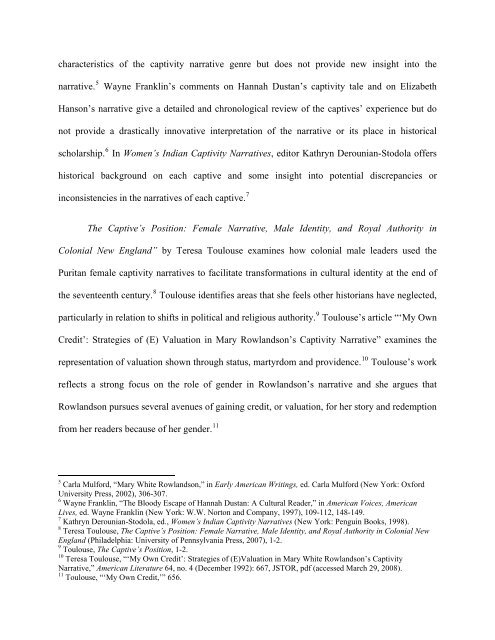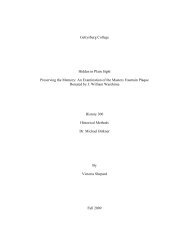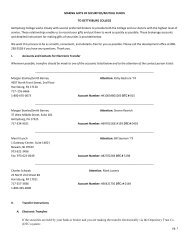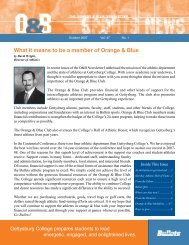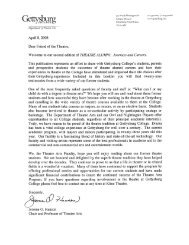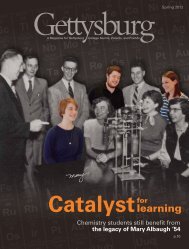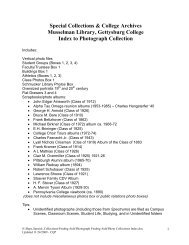Sweet Tooth for Empire: Sugar and the British Atlantic World
Sweet Tooth for Empire: Sugar and the British Atlantic World
Sweet Tooth for Empire: Sugar and the British Atlantic World
You also want an ePaper? Increase the reach of your titles
YUMPU automatically turns print PDFs into web optimized ePapers that Google loves.
characteristics of <strong>the</strong> captivity narrative genre but does not provide new insight into <strong>the</strong><br />
narrative. 5 Wayne Franklin’s comments on Hannah Dustan’s captivity tale <strong>and</strong> on Elizabeth<br />
Hanson’s narrative give a detailed <strong>and</strong> chronological review of <strong>the</strong> captives’ experience but do<br />
not provide a drastically innovative interpretation of <strong>the</strong> narrative or its place in historical<br />
scholarship. 6 In Women’s Indian Captivity Narratives, editor Kathryn Derounian-Stodola offers<br />
historical background on each captive <strong>and</strong> some insight into potential discrepancies or<br />
inconsistencies in <strong>the</strong> narratives of each captive. 7<br />
The Captive’s Position: Female Narrative, Male Identity, <strong>and</strong> Royal Authority in<br />
Colonial New Engl<strong>and</strong>” by Teresa Toulouse examines how colonial male leaders used <strong>the</strong><br />
Puritan female captivity narratives to facilitate trans<strong>for</strong>mations in cultural identity at <strong>the</strong> end of<br />
<strong>the</strong> seventeenth century. 8 Toulouse identifies areas that she feels o<strong>the</strong>r historians have neglected,<br />
particularly in relation to shifts in political <strong>and</strong> religious authority. 9 Toulouse’s article “‘My Own<br />
Credit’: Strategies of (E) Valuation in Mary Rowl<strong>and</strong>son’s Captivity Narrative” examines <strong>the</strong><br />
representation of valuation shown through status, martyrdom <strong>and</strong> providence. 10 Toulouse’s work<br />
reflects a strong focus on <strong>the</strong> role of gender in Rowl<strong>and</strong>son’s narrative <strong>and</strong> she argues that<br />
Rowl<strong>and</strong>son pursues several avenues of gaining credit, or valuation, <strong>for</strong> her story <strong>and</strong> redemption<br />
from her readers because of her gender. 11<br />
5<br />
Carla Mul<strong>for</strong>d, “Mary White Rowl<strong>and</strong>son,” in Early American Writings, ed. Carla Mul<strong>for</strong>d (New York: Ox<strong>for</strong>d<br />
University Press, 2002), 306-307.<br />
6<br />
Wayne Franklin, “The Bloody Escape of Hannah Dustan: A Cultural Reader,” in American Voices, American<br />
Lives, ed. Wayne Franklin (New York: W.W. Norton <strong>and</strong> Company, 1997), 109-112, 148-149.<br />
7<br />
Kathryn Derounian-Stodola, ed., Women’s Indian Captivity Narratives (New York: Penguin Books, 1998).<br />
8<br />
Teresa Toulouse, The Captive’s Position: Female Narrative, Male Identity, <strong>and</strong> Royal Authority in Colonial New<br />
Engl<strong>and</strong> (Philadelphia: University of Pennsylvania Press, 2007), 1-2.<br />
9<br />
Toulouse, The Captive’s Position, 1-2.<br />
10<br />
Teresa Toulouse, “‘My Own Credit’: Strategies of (E)Valuation in Mary White Rowl<strong>and</strong>son’s Captivity<br />
Narrative,” American Literature 64, no. 4 (December 1992): 667, JSTOR, pdf (accessed March 29, 2008).<br />
11<br />
Toulouse, “‘My Own Credit,’” 656.


